hood release CHEVROLET CITY EXPRESS 2018 Owner's Manual
[x] Cancel search | Manufacturer: CHEVROLET, Model Year: 2018, Model line: CITY EXPRESS, Model: CHEVROLET CITY EXPRESS 2018Pages: 287, PDF Size: 4.19 MB
Page 8 of 287
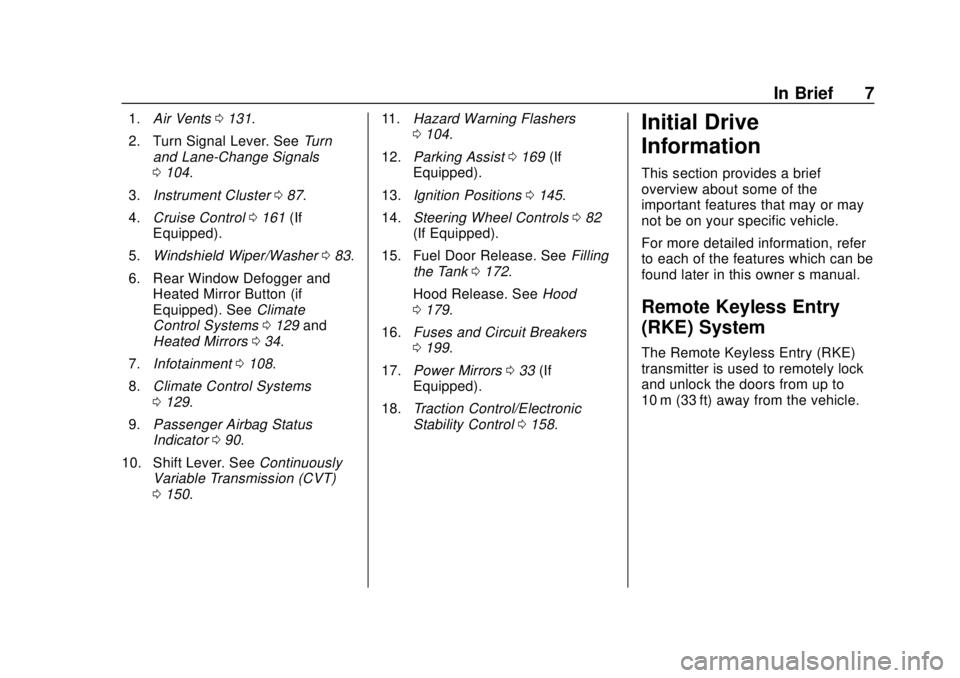
Chevrolet City Express Owner Manual (GMNA-Localizing-U.S./Canada-
11683523) - 2018 - CRC - 7/10/17
In Brief 7
1.Air Vents 0131.
2. Turn Signal Lever. See Turn
and Lane-Change Signals
0 104.
3. Instrument Cluster 087.
4. Cruise Control 0161 (If
Equipped).
5. Windshield Wiper/Washer 083.
6. Rear Window Defogger and Heated Mirror Button (if
Equipped). See Climate
Control Systems 0129 and
Heated Mirrors 034.
7. Infotainment 0108.
8. Climate Control Systems
0129.
9. Passenger Airbag Status
Indicator 090.
10. Shift Lever. See Continuously
Variable Transmission (CVT)
0 150. 11.
Hazard Warning Flashers
0104.
12. Parking Assist 0169 (If
Equipped).
13. Ignition Positions 0145.
14. Steering Wheel Controls 082
(If Equipped).
15. Fuel Door Release. See Filling
the Tank 0172.
Hood Release. See Hood
0 179.
16. Fuses and Circuit Breakers
0199.
17. Power Mirrors 033 (If
Equipped).
18. Traction Control/Electronic
Stability Control 0158.Initial Drive
Information
This section provides a brief
overview about some of the
important features that may or may
not be on your specific vehicle.
For more detailed information, refer
to each of the features which can be
found later in this owner ’s manual.
Remote Keyless Entry
(RKE) System
The Remote Keyless Entry (RKE)
transmitter is used to remotely lock
and unlock the doors from up to
10 m (33 ft) away from the vehicle.
Page 148 of 287
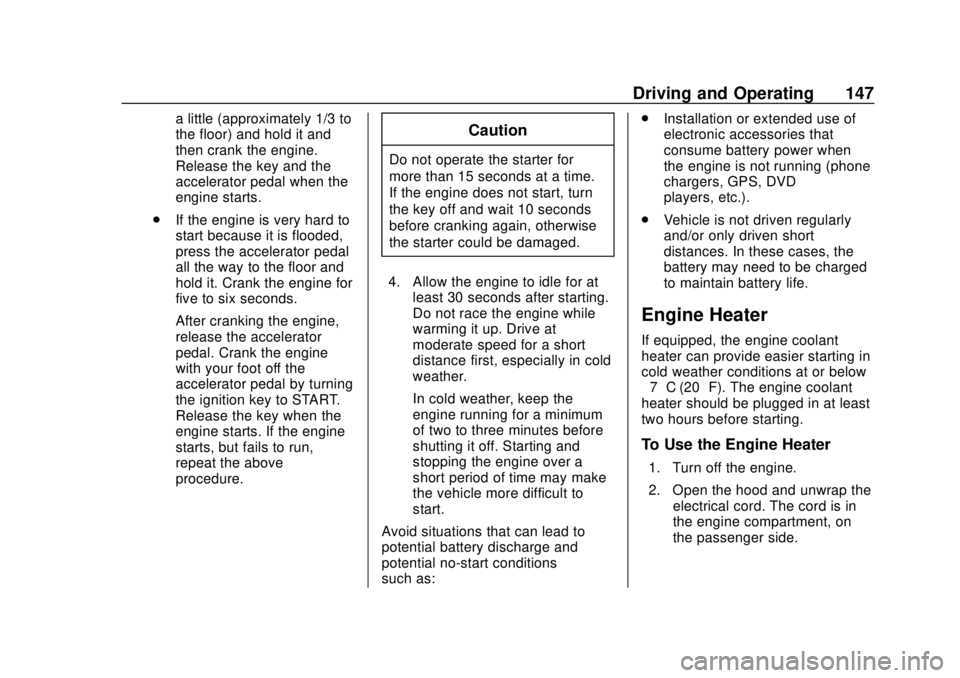
Chevrolet City Express Owner Manual (GMNA-Localizing-U.S./Canada-
11683523) - 2018 - CRC - 7/10/17
Driving and Operating 147
a little (approximately 1/3 to
the floor) and hold it and
then crank the engine.
Release the key and the
accelerator pedal when the
engine starts.
. If the engine is very hard to
start because it is flooded,
press the accelerator pedal
all the way to the floor and
hold it. Crank the engine for
five to six seconds.
After cranking the engine,
release the accelerator
pedal. Crank the engine
with your foot off the
accelerator pedal by turning
the ignition key to START.
Release the key when the
engine starts. If the engine
starts, but fails to run,
repeat the above
procedure.Caution
Do not operate the starter for
more than 15 seconds at a time.
If the engine does not start, turn
the key off and wait 10 seconds
before cranking again, otherwise
the starter could be damaged.
4. Allow the engine to idle for at least 30 seconds after starting.
Do not race the engine while
warming it up. Drive at
moderate speed for a short
distance first, especially in cold
weather.
In cold weather, keep the
engine running for a minimum
of two to three minutes before
shutting it off. Starting and
stopping the engine over a
short period of time may make
the vehicle more difficult to
start.
Avoid situations that can lead to
potential battery discharge and
potential no-start conditions
such as: .
Installation or extended use of
electronic accessories that
consume battery power when
the engine is not running (phone
chargers, GPS, DVD
players, etc.).
. Vehicle is not driven regularly
and/or only driven short
distances. In these cases, the
battery may need to be charged
to maintain battery life.
Engine Heater
If equipped, the engine coolant
heater can provide easier starting in
cold weather conditions at or below
−7 °C (20 °F). The engine coolant
heater should be plugged in at least
two hours before starting.
To Use the Engine Heater
1. Turn off the engine.
2. Open the hood and unwrap the
electrical cord. The cord is in
the engine compartment, on
the passenger side.
Page 160 of 287
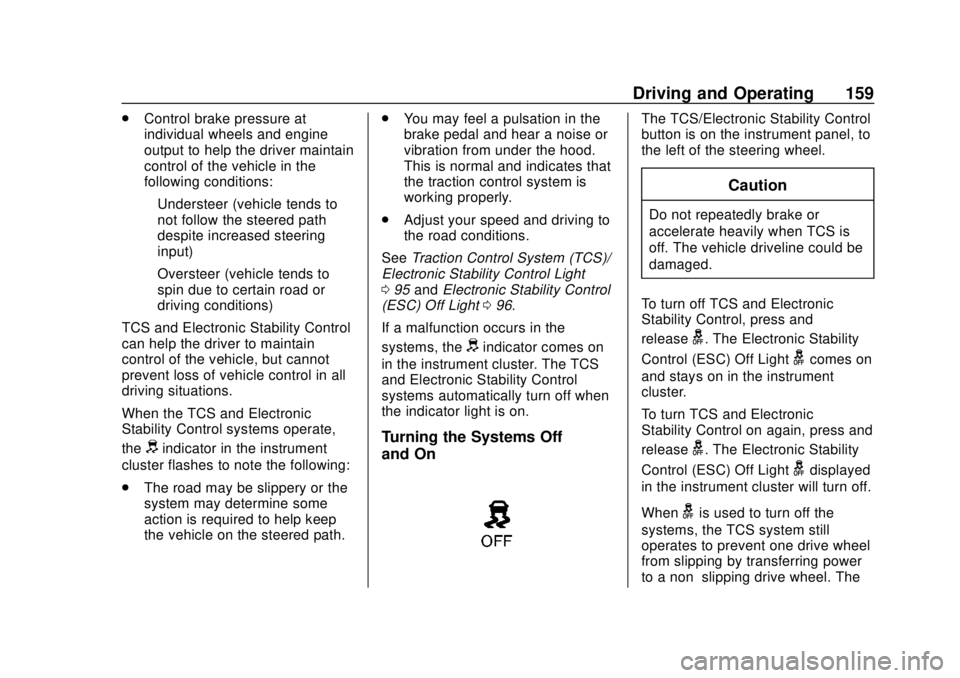
Chevrolet City Express Owner Manual (GMNA-Localizing-U.S./Canada-
11683523) - 2018 - CRC - 7/10/17
Driving and Operating 159
.Control brake pressure at
individual wheels and engine
output to help the driver maintain
control of the vehicle in the
following conditions:
‐Understeer (vehicle tends to
not follow the steered path
despite increased steering
input)
‐ Oversteer (vehicle tends to
spin due to certain road or
driving conditions)
TCS and Electronic Stability Control
can help the driver to maintain
control of the vehicle, but cannot
prevent loss of vehicle control in all
driving situations.
When the TCS and Electronic
Stability Control systems operate,
the
dindicator in the instrument
cluster flashes to note the following:
. The road may be slippery or the
system may determine some
action is required to help keep
the vehicle on the steered path. .
You may feel a pulsation in the
brake pedal and hear a noise or
vibration from under the hood.
This is normal and indicates that
the traction control system is
working properly.
. Adjust your speed and driving to
the road conditions.
See Traction Control System (TCS)/
Electronic Stability Control Light
0 95 and Electronic Stability Control
(ESC) Off Light 096.
If a malfunction occurs in the
systems, the
dindicator comes on
in the instrument cluster. The TCS
and Electronic Stability Control
systems automatically turn off when
the indicator light is on.
Turning the Systems Off
and On
The TCS/Electronic Stability Control
button is on the instrument panel, to
the left of the steering wheel.
Caution
Do not repeatedly brake or
accelerate heavily when TCS is
off. The vehicle driveline could be
damaged.
To turn off TCS and Electronic
Stability Control, press and
release
g. The Electronic Stability
Control (ESC) Off Light
gcomes on
and stays on in the instrument
cluster.
To turn TCS and Electronic
Stability Control on again, press and
release
g. The Electronic Stability
Control (ESC) Off Light
gdisplayed
in the instrument cluster will turn off.
When
gis used to turn off the
systems, the TCS system still
operates to prevent one drive wheel
from slipping by transferring power
to a non–slipping drive wheel. The
Page 180 of 287
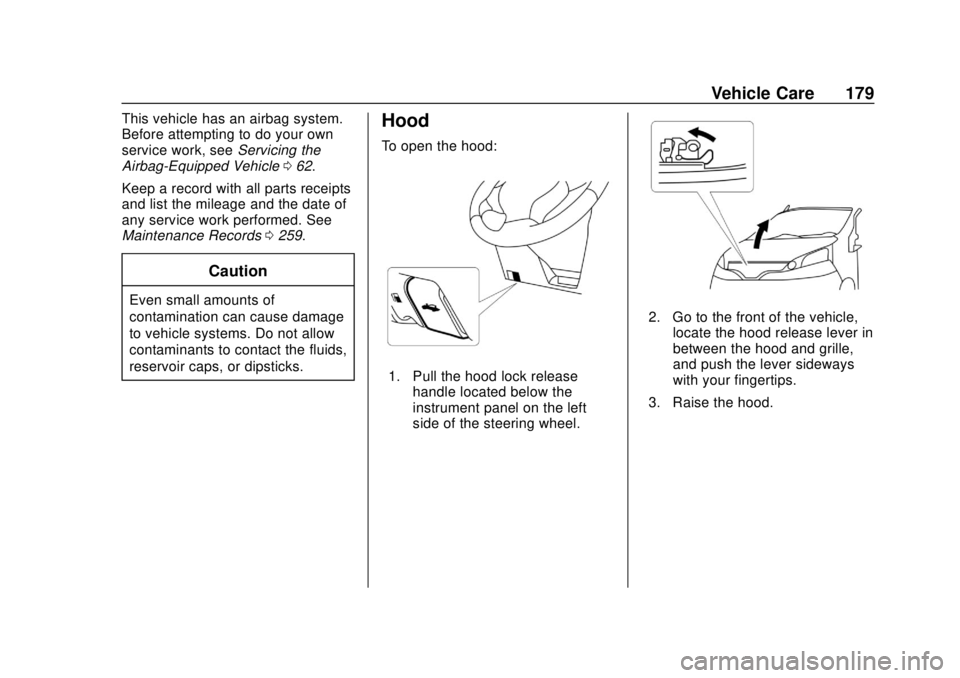
Chevrolet City Express Owner Manual (GMNA-Localizing-U.S./Canada-
11683523) - 2018 - CRC - 7/10/17
Vehicle Care 179
This vehicle has an airbag system.
Before attempting to do your own
service work, seeServicing the
Airbag-Equipped Vehicle 062.
Keep a record with all parts receipts
and list the mileage and the date of
any service work performed. See
Maintenance Records 0259.
Caution
Even small amounts of
contamination can cause damage
to vehicle systems. Do not allow
contaminants to contact the fluids,
reservoir caps, or dipsticks.
Hood
To open the hood:
1. Pull the hood lock release
handle located below the
instrument panel on the left
side of the steering wheel.
2. Go to the front of the vehicle,locate the hood release lever in
between the hood and grille,
and push the lever sideways
with your fingertips.
3. Raise the hood.
Page 181 of 287
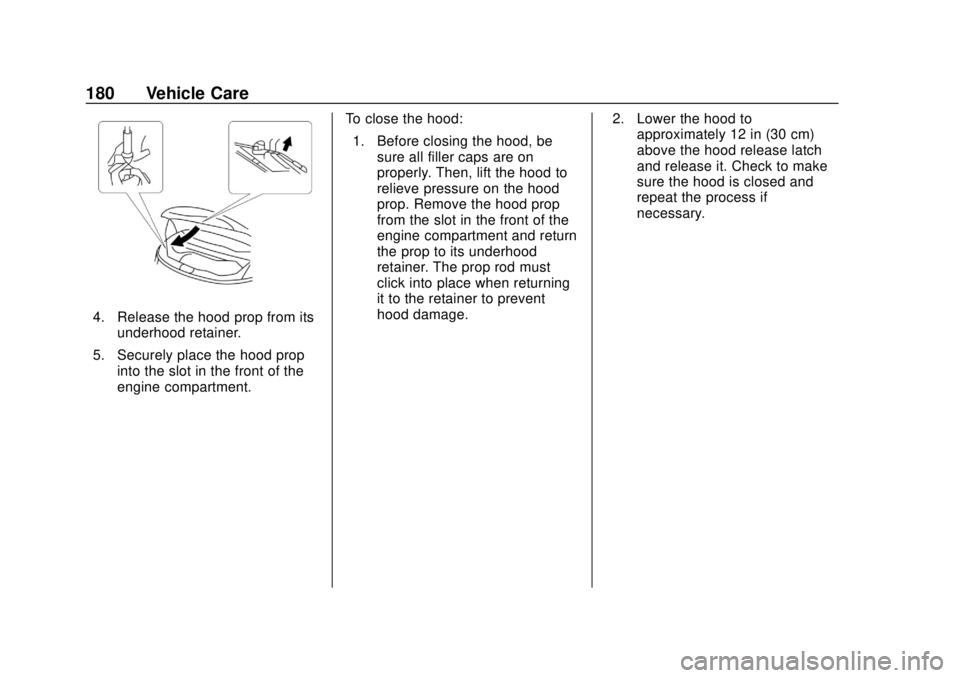
Chevrolet City Express Owner Manual (GMNA-Localizing-U.S./Canada-
11683523) - 2018 - CRC - 7/10/17
180 Vehicle Care
4. Release the hood prop from itsunderhood retainer.
5. Securely place the hood prop into the slot in the front of the
engine compartment. To close the hood:
1. Before closing the hood, be sure all filler caps are on
properly. Then, lift the hood to
relieve pressure on the hood
prop. Remove the hood prop
from the slot in the front of the
engine compartment and return
the prop to its underhood
retainer. The prop rod must
click into place when returning
it to the retainer to prevent
hood damage. 2. Lower the hood to
approximately 12 in (30 cm)
above the hood release latch
and release it. Check to make
sure the hood is closed and
repeat the process if
necessary.
Page 197 of 287
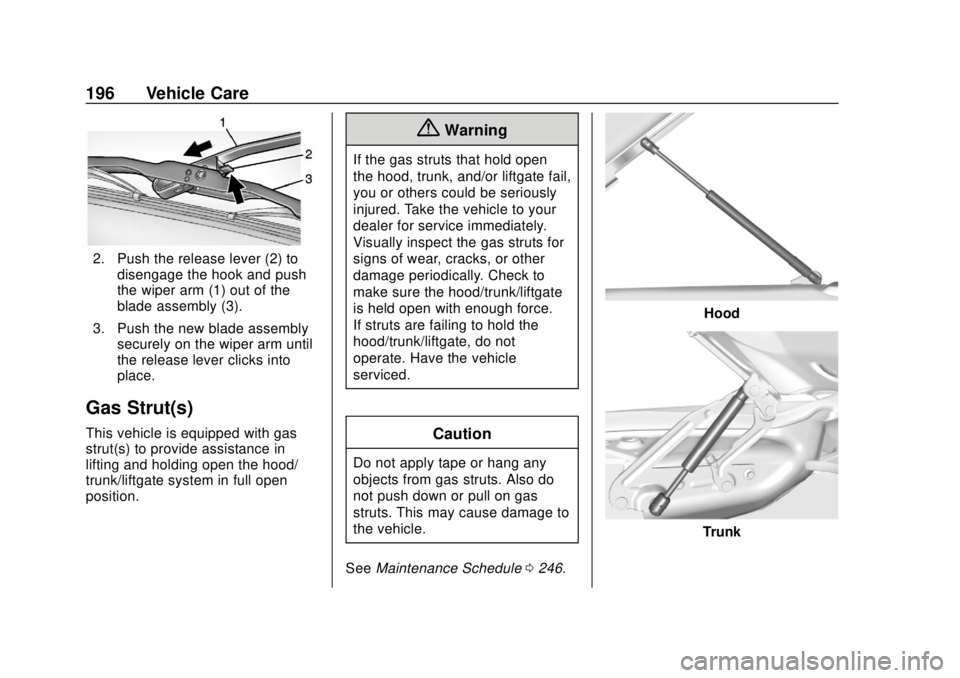
Chevrolet City Express Owner Manual (GMNA-Localizing-U.S./Canada-
11683523) - 2018 - CRC - 7/10/17
196 Vehicle Care
2. Push the release lever (2) todisengage the hook and push
the wiper arm (1) out of the
blade assembly (3).
3. Push the new blade assembly securely on the wiper arm until
the release lever clicks into
place.
Gas Strut(s)
This vehicle is equipped with gas
strut(s) to provide assistance in
lifting and holding open the hood/
trunk/liftgate system in full open
position.
{Warning
If the gas struts that hold open
the hood, trunk, and/or liftgate fail,
you or others could be seriously
injured. Take the vehicle to your
dealer for service immediately.
Visually inspect the gas struts for
signs of wear, cracks, or other
damage periodically. Check to
make sure the hood/trunk/liftgate
is held open with enough force.
If struts are failing to hold the
hood/trunk/liftgate, do not
operate. Have the vehicle
serviced.
Caution
Do not apply tape or hang any
objects from gas struts. Also do
not push down or pull on gas
struts. This may cause damage to
the vehicle.
See Maintenance Schedule 0246.
Hood
Trunk
Page 199 of 287

Chevrolet City Express Owner Manual (GMNA-Localizing-U.S./Canada-
11683523) - 2018 - CRC - 7/10/17
198 Vehicle Care
Headlamps, Front Turn
Signal and Parking
Lamps
High-Beam Headlamp/
Low-Beam Headlamp
1. Open the hood.
2. Release the clip on theconnector.
3. Turn the bulb counterclockwise and pull straight back.
Turn Signal and Parking Lamp
1. Open the hood.
2. Turn the bulb counterclockwise
and pull straight back.
Electrical System
Electrical System
Overload
The vehicle has fuses and circuit
breakers to protect against an
electrical system overload.
When the current electrical load is
too heavy, the circuit breaker opens
and closes, protecting the circuit
until the current load returns to
normal or the problem is fixed. This
greatly reduces the chance of circuit
overload and fire caused by
electrical problems.
Fuses and circuit breakers protect
power devices in the vehicle.
Replace a bad fuse with a new one
of the identical size and rating.
If there is a problem on the road and
a fuse needs to be replaced, the
same amperage fuse can be
borrowed. Choose some feature of
the vehicle that is not needed to use
and replace it as soon as possible.
Headlamp Wiring
An electrical overload may cause
the lamps to go on and off, or in
some cases to remain off. Have the
headlamp wiring checked right away
if the lamps go on and off or
remain off.
Windshield Wipers
If the wiper motor overheats due to
heavy snow or ice, the windshield
wipers will stop until the motor cools
and will then restart.
Although the circuit is protected
from electrical overload, overload
due to heavy snow or ice may
cause wiper linkage damage.
Always clear ice and heavy snow
from the windshield before using the
windshield wipers.
If the overload is caused by an
electrical problem and not snow or
ice, be sure to get it fixed.
Page 244 of 287
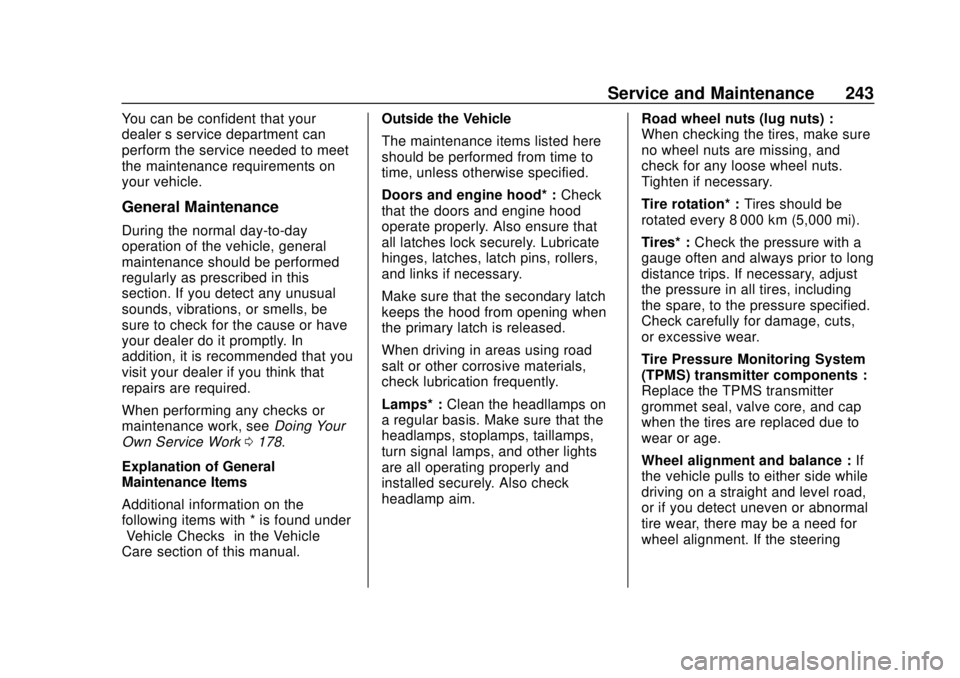
Chevrolet City Express Owner Manual (GMNA-Localizing-U.S./Canada-
11683523) - 2018 - CRC - 7/10/17
Service and Maintenance 243
You can be confident that your
dealer’s service department can
perform the service needed to meet
the maintenance requirements on
your vehicle.
General Maintenance
During the normal day-to-day
operation of the vehicle, general
maintenance should be performed
regularly as prescribed in this
section. If you detect any unusual
sounds, vibrations, or smells, be
sure to check for the cause or have
your dealer do it promptly. In
addition, it is recommended that you
visit your dealer if you think that
repairs are required.
When performing any checks or
maintenance work, see Doing Your
Own Service Work 0178.
Explanation of General
Maintenance Items
Additional information on the
following items with * is found under
“Vehicle Checks” in the Vehicle
Care section of this manual. Outside the Vehicle
The maintenance items listed here
should be performed from time to
time, unless otherwise specified.
Doors and engine hood* :
Check
that the doors and engine hood
operate properly. Also ensure that
all latches lock securely. Lubricate
hinges, latches, latch pins, rollers,
and links if necessary.
Make sure that the secondary latch
keeps the hood from opening when
the primary latch is released.
When driving in areas using road
salt or other corrosive materials,
check lubrication frequently.
Lamps* : Clean the headllamps on
a regular basis. Make sure that the
headlamps, stoplamps, taillamps,
turn signal lamps, and other lights
are all operating properly and
installed securely. Also check
headlamp aim. Road wheel nuts (lug nuts) :
When checking the tires, make sure
no wheel nuts are missing, and
check for any loose wheel nuts.
Tighten if necessary.
Tire rotation* :
Tires should be
rotated every 8 000 km (5,000 mi).
Tires* : Check the pressure with a
gauge often and always prior to long
distance trips. If necessary, adjust
the pressure in all tires, including
the spare, to the pressure specified.
Check carefully for damage, cuts,
or excessive wear.
Tire Pressure Monitoring System
(TPMS) transmitter components :
Replace the TPMS transmitter
grommet seal, valve core, and cap
when the tires are replaced due to
wear or age.
Wheel alignment and balance : If
the vehicle pulls to either side while
driving on a straight and level road,
or if you detect uneven or abnormal
tire wear, there may be a need for
wheel alignment. If the steering